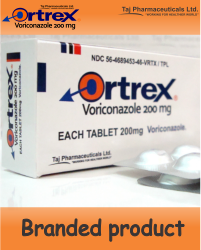FULL PRESCRIBING INFORMATION - WARNINGS AND PRECAUTIONS

Ortrex Details
Contact Us
Taj Pharma India Brands
Taj Pharma Group (India)
214, Bake House, Bake House Lane,
Fort, Mumbai 400001, India.
E-mail: ortrex@tajpharma.com





WARNINGS AND PRECAUTIONS
 Drug Interactions
Drug Interactions
a listing of drugs that may significantly alter voriconazole concentrations and that may interact with voriconazole resulting in altered pharmacokinetics or pharmacodynamics of the other drug [see Contraindications and Drug Interactions ].
Hepatic Toxicity
In clinical trials, there have been uncommon cases of serious hepatic reactions during treatment with voriconazole (including clinical hepatitis, cholestasis and fulminant hepatic failure, including fatalities). Instances of hepatic reactions were noted to occur primarily in patients with serious underlying medical conditions (predominantly hematological malignancy). Hepatic reactions, including hepatitis and jaundice, have occurred among patients with no other identifiable risk factors. Liver dysfunction has usually been reversible on discontinuation of therapy [seeWarnings and Precautions and Adverse Reactions].
Monitoring of Hepatic Function
Liver function tests should be evaluated at the start of and during the course of voriconazole therapy. Patients who develop abnormal liver function tests during voriconazole therapy should be monitored for the development of more severe hepatic injury. Patient management should include laboratory evaluation of hepatic function (particularly liver function tests and bilirubin). Discontinuation of voriconazole must be considered if clinical signs and symptoms consistent with liver disease develop that may be attributable to voriconazole [see Warnings and Precautions, Dosage and Administration and Adverse Reactions ].
Visual Disturbances
The effect of voriconazole on visual function is not known if treatment continues beyond 28 days.There have been post-marketing reports of prolonged visual adverse events, including optic neuritis and papilledema. If treatment continues beyond 28 days, visual function including visual acuity, visual field and color perception should be monitored [see Adverse Reactions ].
Pregnancy Category D
Voriconazole can cause fetal harm when administered to a pregnant woman.
In animals, voriconazole administration was associated with teratogenicity, embryotoxicity, increased gestational length, dystocia and embryomortality. Please refer to section 8.1 (Pregnancy) for additional details.
If this drug is used during pregnancy or if the patient becomes pregnant while taking this drug, the patient should be informed of the potential hazard to the fetus.
Galactose Intolerance
Voriconazole tablets contain lactose and should not be given to patients with rare hereditary problems of galactose intolerance, Lapp lactase deficiency or glucose-galactose malabsorption.
Arrhythmias and QT Prolongation
Some azoles, including voriconazole, have been associated with prolongation of the QT interval on the electrocardiogram. During clinical development and post-marketing surveillance, there have been rare cases of arrhythmias, (including ventricular arrhythmias such as torsade de pointes), cardiac arrests and sudden deaths in patients taking voriconazole. These cases usually involved seriously ill patients with multiple confounding risk factors, such as history of cardiotoxic chemotherapy, cardiomyopathy, hypokalemia and concomitant medications that may have been contributory.
Voriconazole should be administered with caution to patients with these potentially proarrhythmic conditions.
Rigorous attempts to correct potassium, magnesium and calcium should be made before starting voriconazole [see Clinical Pharmacology ].
Laboratory Tests
Electrolyte disturbances such as hypokalemia, hypomagnesemia and hypocalcemia should be corrected prior to initiation of voriconazole therapy.
Patient management should include laboratory evaluation of renal (particularly serum creatinine) and hepatic function (particularly liver function tests and bilirubin).
Patients with Hepatic Impairment
It is recommended that the standard loading dose regimens be used but that the maintenance dose be halved in patients with mild to moderate hepatic cirrhosis (Child-Pugh Class A and B) receiving voriconazole [see Clinical Pharmacology and Dosage and Administration ].
Voriconazole has not been studied in patients with severe cirrhosis (Child-Pugh Class C). Voriconazole has been associated with elevations in liver function tests and clinical signs of liver damage, such as jaundice and should only be used in patients with severe hepatic insufficiency if the benefit outweighs the potential risk. Patients with hepatic insufficiency must be carefully monitored for drug toxicity.
Patients with Renal Impairment
n patients with moderate to severe renal dysfunction (creatinine clearance < 50 mL/min), accumulation of the intravenous vehicle, SBECD, occurs. Oral voriconazole should be administered to these patients, unless an assessment of the benefit/risk to the patient justifies the use of intravenous voriconazole. Serum creatinine levels should be closely monitored in these patients and if increases occur, consideration should be given to changing to oral voriconazole therapy [see Clinical Pharmacology and Dosage and Administration ].
Monitoring of Renal Function
Acute renal failure has been observed in patients undergoing treatment with voriconazole. Patients being treated with voriconazole are likely to be treated concomitantly with nephrotoxic medications and have concurrent conditions that may result in decreased renal function.
Patients should be monitored for the development of abnormal renal function. This should include laboratory evaluation, particularly serum creatinine.
Monitoring of Pancreatic Function
Patients with risk factors for acute pancreatitis (e.g., recent chemotherapy, hematopoietic stem cell transplantation [HSCT]) should be monitored for the development of pancreatitis during voriconazole treatmen
Dermatological Reactions
Serious exfoliative cutaneous reactions, such as Stevens-Johnson Syndrome, have been reported during treatment with voriconazole. If a patient develops an exfoliative cutaneous reaction, voriconazole should be discontinued.
In addition voriconazole has been associated with photosensitivity skin reaction. Patients should avoid intense or prolonged exposure to direct sunlight during voriconazole treatment. In patients with photosensitivity skin reactions squamous cell carcinoma of the skin and melanoma have been reported during long-term therapy. If a patient develops a skin lesion consistent with squamous cell carcinoma or melanoma, voriconazole should be discontinued.
Skeletal Adverse Events
Fluorosis and periostitis have been reported during long-term voriconazole therapy. If a patient develops skeletal pain and radiologic findings compatible with fluorosis or periostitis, voriconazole should be discontinued [see Adverse Reactions ].
Download Ortrex Overview
Ortrex® Voriconazole 200mg tablets are a prescription medicine used to treat certain serious fungal infections in your blood and body. Ortrex® Voriconazole 200mg tablets sold by Taj Pharmaceuticals Limited (India), a global pharmaceuticals company. It is available in India, Middle East and a few other South Asian countries.
![]() Ortrex® Voriconazole 200mg tablets_CMI
Ortrex® Voriconazole 200mg tablets_CMI
![]() Ortrex® Voriconazole 200mg tablets_FPI
Ortrex® Voriconazole 200mg tablets_FPI


 Home
Home